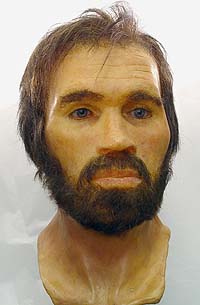Lindow Man facts for kids
Lindow Man, also known as Lindow II and (in jest) as Pete Marsh, is the preserved bog body of a man discovered in a peat bog at Lindow Moss near Wilmslow in Cheshire, North West England. The remains were found on 1 August 1984 by commercial peat cutters. Lindow Man is not the only bog body to have been found in the moss; Lindow Woman was discovered the year before, and other body parts have also been recovered. The find was described as "one of the most significant archaeological discoveries of the 1980s" and caused a media sensation.
At the time of death, Lindow Man was a healthy male in his mid-20s, and may have been of high social status as his body shows little evidence of having done heavy or rough physical labour during his lifetime. There has been debate over the reason for his death. Dating the body has proven problematic, but scientists agree that Lindow Man must have died between 2 BC and 119 AD, either in the Iron Age or Romano-British period.
The recovered body has been preserved by freeze-drying and is on permanent display at the British Museum, although it occasionally travels to other venues such as the Manchester Museum.
Background
Lindow Moss
Lindow Moss is a peat bog in Lindow, an area of Wilmslow, Cheshire, which has been used as common land since the medieval period. It formed after the last ice age, one of many such peat bogs in north-east Cheshire and the Mersey basin that formed in hollows caused by melting ice. Investigations have not yet discovered settlement or agricultural activity around the edge of Lindow Moss that would have been contemporary with Lindow Man; however, analysis of pollen in the peat suggests there was some cultivation in the vicinity.
Once covering over 600 hectares (1,500 acres), the bog has now shrunk to a tenth of its original size. It is a dangerous place; an 18th-century writer recorded people drowning there. For centuries the peat from the bog was used as fuel, and it continued to be extracted until the 1980s, by which time the process had been mechanised.
Lindow Woman
On 13 May 1983, two peat workers at Lindow Moss, Andy Mould and Stephen Dooley, found remains of a European woman, probably aged 30–50. Her skull was later radiocarbon dated, revealing it to be nearly 2,000 years old. "Lindow Woman", as it became known, dated from around 210 AD.
Discovery
A year later, a further discovery was made at Lindow Moss, just 820 feet (250 m) south-west of the Lindow Woman. On 1 August 1984, Andy Mould, who had been involved in the discovery of Lindow Woman, found the remains of Lindow Man. The landowners on where Lindow Man was found donated the body to the British Museum, and on 21 August it was transported to London. At the time, the body was dubbed "Pete Marsh" by Middlesex Hospital radiologists, a name subsequently adopted by local journalists, as was the similar "Pete Bogg".
The find was announced to the press during the second week of investigation. As the best preserved bog body found in Britain, its discovery caused a domestic media sensation and received global coverage. Sparking excitement in the country's archaeological community, who had long expected such a find, it was hailed as one of the most important archaeological discoveries of the 1980s. A Q.E.D. documentary about Lindow Man broadcast by the BBC in 1985 attracted 10 million viewers.
Remains and investigation
Lindow Man marked the first discovery in Britain of a well-preserved bog body; its condition was comparable to that of Grauballe Man and Tollund Man from Denmark.
In life, Lindow Man would have measured between 5'6" and 5'8" (1.68 and 1.73 m) tall and weighed about 132 pounds (60 kg). It was possible to ascertain that his age at death was around the mid-20s. The body retains a trimmed beard, moustache, and sideburns of brown hair, as well as healthy teeth with no visible cavities, and manicured fingernails, indicating he did little heavy or rough work.
Lindow Man's last meal was preserved in his stomach and was analysed in some detail. Analysis of the contents of the stomach revealed his diet to be mostly of cereals. Some mistletoe pollen was also found in the stomach, indicating that Lindow Man died in March or April.
One of the conclusions of the study was that the people buried in Lindow Moss may have had a less varied diet than their European counterparts. According to Jody Joy, curator of the Iron Age collection at the British Museum, the importance of Lindow Man lies more in how he lived rather than how he died, as the circumstances surrounding his demise may never be fully established.
Lindow Man is held in the British Museum. Before the remains were transferred there, people from North West England launched an unsuccessful campaign to keep the body in Manchester. Critics have complained that, by museum display of the remains, the body of Lindow Man has been objectified rather than treated with the respect due the dead.
See also
 In Spanish: Hombre de Lindow para niños
In Spanish: Hombre de Lindow para niños



